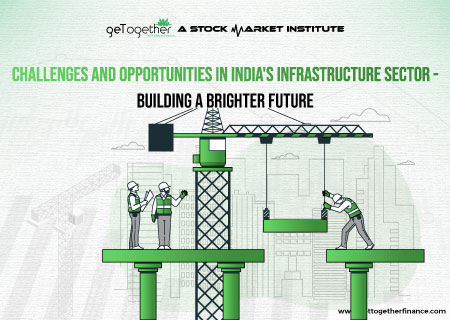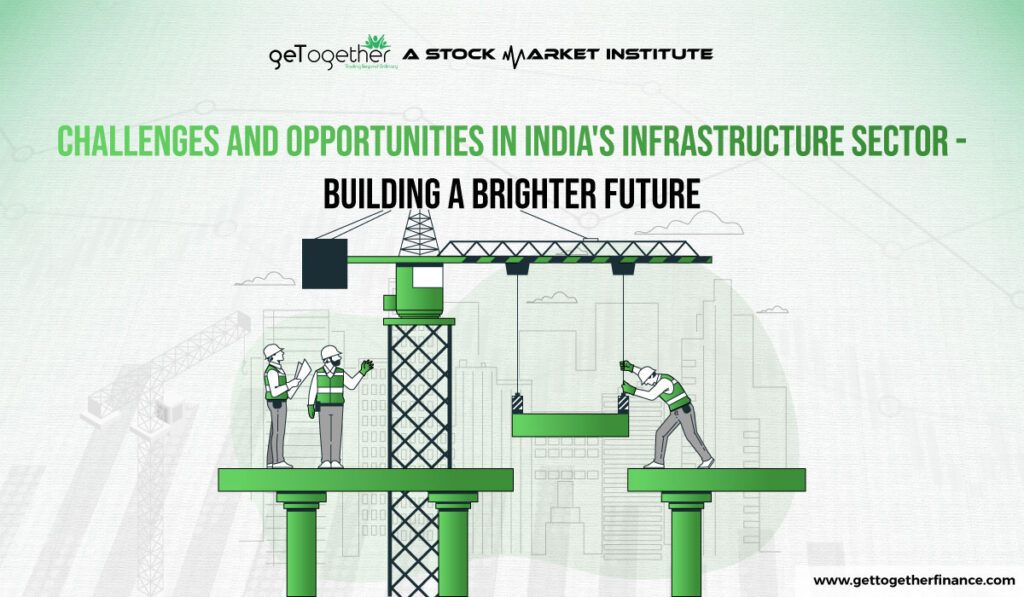Challenges and Opportunities in India’s Infrastructure Sector – Building a Brighter Future


Overview
India’s infrastructure sector presents immense opportunities as the country looks forward to becoming a developed nation by 2047. The mission has created a major scope of development and advancement opportunities. But what comes unsaid is a multitude of challenges.
India is a country of diverse cultures, holding the position of the most populated nation worldwide. Hence, to sustain and grow with the agenda, it is crucial to improve per person per capita and robust infrastructure development. With this blog, we will explore potential challenges and opportunities in the infrastructure sector of India.
What is the Proposed Allocation in the 2024-25 Budget?

With every year’s budget, the government allocates specific funds to each sector. Here let’s take a look at the proposed allocation in the 2024-25 budget and the areas focused on during the outlining of the budget:
- The government has allocated 3.3% of GDP to the infrastructure sector in the fiscal year 2024.
- The total budgetary outlay for infrastructure-related ministries increased from around INR 3.7 Lakh Crore in FY23 to INR 5 Lakh Crore in FY24.
- This increased allocation offers notable investment prospects for the private sector across various transport sub-segments like roads, railways, airports, and ports.
- The state has also set ambitious targets for the transport sector, including the development of a 2 lakh-km national highway network by 2025 and expanding airports to 220.
- Plans also include operationalizing 23 waterways by 2030 and developing 35 Multi-Modal Logistics Parks (MMLPs).
The 2024-25 Indian budget has significantly raised the allocation for the infrastructure sector, showcasing the government’s commitment to developing world-class infrastructure to support the country’s economic growth and development goals.
Challenges in Infrastructure Development in India

Building infrastructure is no easy task and includes all sorts of limitations to overcome, from political and regulatory risks to land acquisition issues and environmental concerns.
Let’s explore the major setbacks in the infrastructure development sector in India:
Private Sector Capacity
The private sector has a big role to play in infrastructure, but often they are not able to handle massive projects and don’t hold the capacity to manage the massive size of projects.
Political and Regulatory Risks
The infrastructure sector projects lifecycle involves various approvals across stages, from pre-tendering to post-construction. Governments can be tricky when it comes to quickly operating the projects. If the community opposes an investment or the rules change midway, it can cause obstacles or can restrain development. In India, the government not paying what it promised is a big worry for investors.
Land Acquisition
Land is a sensitive topic, and acquiring it for big projects can be a real drill. Farmers and local communities often resist when their land is taken for projects. And if the process isn’t smooth and fair, investors might not even bother bidding in the first place. Large projects like roads and energy facilities can take a long time to start because of this.
Environmental Impact Assessment
Protecting the environment is important, but it can also slow things down. The rules are always changing, and new projects have to follow the latest standards, even if they’re already underway. It’s a tricky balance to strike.
Access to Financing
Infrastructure projects take a long time to pay off, and that’s not always easy for investors and lenders to stomach. After the global financial crisis, it became harder to get long-term loans, even in India.
Also Read: Ethanol Fuel
Opportunities in Infrastructure Sector in India

We all have heard the old adage, “if one door closes, the window opens”. So here are some challenges that can be converted into opportunities in the infrastructure sector of India:
Public-Private Partnerships (PPPs)
PPPs can help bridge the funding gap by bringing together the government’s resources and the private sector’s expertise. The government provides support and a share of the profits, while private companies bring their know-how to the table. It’s a win-win situation, and it’s worked well in sectors like roads, ports, and airports in India.
Leveraging Technology
With all the high-tech inclusion nowadays like the Internet of Things, AI, and Big Data, we can revolutionize the infrastructure sector to pace the process and introduce state-of-the-art infra relatively. From planning to maintenance, these tools can make everything run smoother.
Focus on Sustainable Infrastructure
With the world going green, there’s a chance for India to build infrastructure that’s eco-friendly. The country can tap into green financing and use sustainable design principles to create projects that are good for the planet. Solar parks, green buildings, and clean transport systems are just a few examples of what’s possible.
Regional Connectivity
While the big cities are booming, connecting smaller towns and cities can open up new opportunities for growth. The UDAN scheme, which aims to improve regional air connectivity, is a step in the right direction.
Skill Development
Building infrastructure is a great way to develop skills too. By investing in training programs, India can create a workforce that’s ready to tackle challenges in infrastructure of the modern world.
Measures Needed To Pace The Process of Infrastructure Development

Here are some measures that can be considered to accelerate the process of development and meet our mission of listing as a developed country. Let’s take a look:
Fast-track Policy and Regulation Reforms
Sponsoring agencies need to collaborate together and create strong performance management systems to ensure projects are executed on time. It includes setting performance standards, tracking progress accurately, and using incentives and penalties to keep everyone on their toes.
Land Acquisition
The government has initiated a good plan by relaxing land transfer rules for the land it owns. This can pace up the growth of the infrastructure sector by helping resolve delays caused by bureaucratic issues. However, it is crucial to ensure the seamless execution of the policies and regulations too.
Facilitating Funds
Setting up Infrastructure Debt Funds and reducing taxes on the interest from these bonds can help attract long-term funding for infrastructure projects. It can be a step in the right direction, preventing the upcoming challenges in the infrastructure sector.
This is not the end of the list as the country’s government can take several other measures into action such as leveraging technology, ensuring multimodal connectivity, ensuring climate resilience and sustainability in the project, etc.
Conclusion
The infrastructure sector is crucial for India’s economic growth and development. As the country aims to become a global economic power, it needs strong infrastructure. Partnering with the private sector is key to making this happen. The infrastructure sector is crucial for India’s economic growth and development. As the country aims to become a global economic power, it needs strong infrastructure. Partnering with the private sector is key to making this happen. By working together, the government and private sector can build infrastructure that is sustainable and inclusive. This will pave the way for a prosperous future for all Indians.
FAQs
What are some exciting opportunities in India’s infrastructure sector?
Growth in renewable energy, smart cities, digital infrastructure, and logistics offer vast opportunities for investment and innovation.
What are the concerns about PPP models in infrastructure projects?
Concerns include project delays due to complex agreements and potential risks for private companies if project returns are lower than anticipated.
How can India attract more foreign investment in infrastructure?
Streamlining approvals, improving project transparency, and offering competitive returns can attract foreign investors.
What are the top 5 infrastructure stocks to invest in India?
Here are the top five stocks that are top in the list currently : Larsen & Toubro, IRB Infrastructure Developers Limited, GMR Airports Infrastructure Limited, Ircon International Limited, HFCL Limited. Although, it is highly suggested to do your own research before investing.



 Facebook
Facebook  Instagram
Instagram  Youtube
Youtube 
